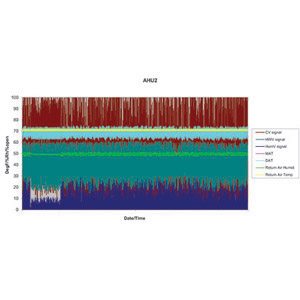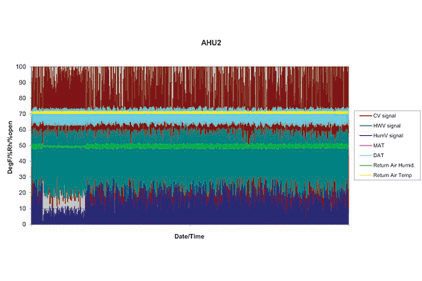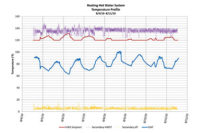
|
|
Figure 1 covers two full days of August, 2010. |
OCTOBER 2011 - TREND LOG ANALYSIS
The critical finding for last month’s parking garage makeup air unit was the essentially constant discharge air temperature of about 60°F from the makeup air unit (red line) when outside air temperatures were less than about 20° to 30°. This indicated that there was an integral discharge air thermostat limiting the amount of heat introduced to the makeup air system.
The 60° supply air temperature was not warm enough to satisfy the garage 60° space temperature (purple line) setpoint on those cold days. Thus, the makeup air/heating system was energized continuously, trying, but not achieving, the 60° space setpoint that would have automatically turned the system off. The system did eventually turn off (yellow line) around January 15, 2010, when the outside air temperature rose towards 30°.
The reason this was so energy intensive is because all of the heating for the garage was designed to be accomplished with 100% outside airflow. As long as the space setpoint was not satisfied, the makeup air unit continued to introduce cold outside air which imposed a huge heating load on the system.
When the discharge air limiting thermostat was adjusted from 60° to 120°, the makeup air system energized only when needed for carbon monoxide control. The higher discharge air temperature resulted in the space temperature setpoint being achieved very quickly, thus allowing the makeup air unit to de-energize until needed again for carbon monoxide dissipation.
NEW SYSTEM
The following graph illustrates the performance of an AHU serving a space with tight temperature and relative humidity requirements in a northern climate. Its outside air is preconditioned (e.g., heated, cooled, and dehumidified) prior to being mixed with the return air. The heating coil is downstream of the cooling coil to allow for dehumidification mode reheat. The space served has no external walls or roof, and indoor conditions need to be maintained continuously 365 days/year. This analysis was conducted as part of a facility-wide retrocommissioning program.
TRENDS
The BAS was used to trend the following sensor and device data at one-minute intervals:
• Chilled water valve signal
• Heating hot water valve signal
• Humidifier valve signal
• Mixed air temperature
• Discharge air temperature
• Return air relative humidity
• Return air temperature
Figure 1 covers two full days of August, 2010. ES







